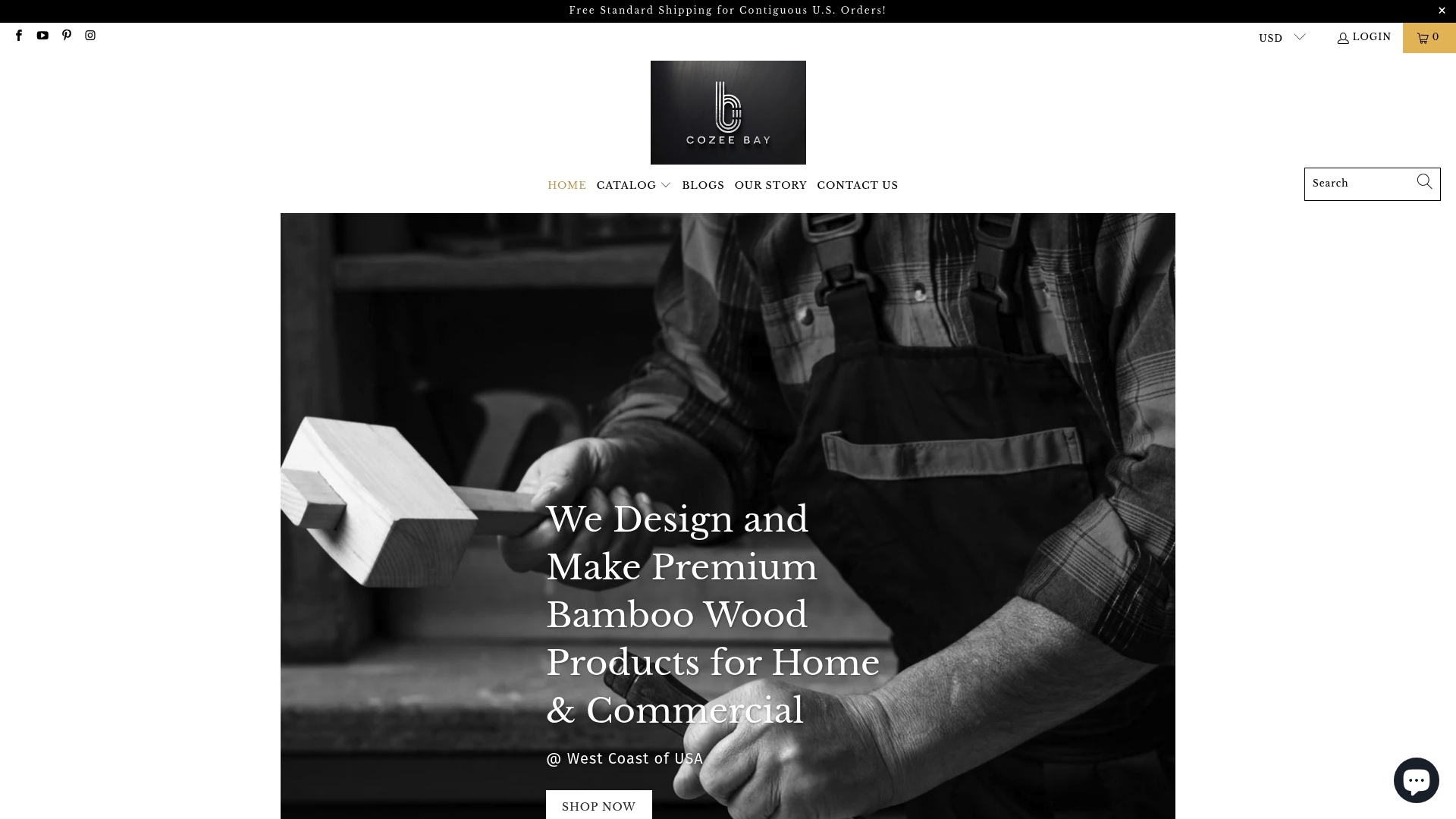Your Cart is Empty
Free Standard Shipping for Contiguous U.S. Orders!
Free Standard Shipping for Contiguous U.S. Orders!
Catalog
Bamboo Wood Explained: Sustainability, Types, and Uses
October 21, 2025 7 min read
Did you know that some bamboo species can grow up to 3 feet in a single day? This rapid growth challenges long-held myths about bamboo and highlights its unique place in the world of sustainable materials. Many people still believe bamboo is weak or simply decorative, yet its impressive strength and versatility are changing how we build, design, and care for our spaces. Discover how bamboo measures up against traditional wood and why it deserves a closer look.
Table of Contents
- Defining Bamboo Wood And Common Myths
- Types Of Bamboo Wood And Processing Methods
- Key Properties And Sustainability Benefits
- Popular Applications In Home And Business
- Care Tips And Comparing Alternatives
Key Takeaways
| Point | Details |
|---|---|
| Bamboo as a Material | Bamboo is a sustainable grass with superior mechanical properties that can rival traditional hardwoods for construction and design purposes. |
| Sustainability Benefits | Bamboo grows rapidly, requires minimal resources, and offers high carbon sequestration, making it an environmentally friendly alternative to traditional timber. |
| Common Myths | Misconceptions persist about bamboo’s strength and durability; in reality, it possesses substantial fiber content that enhances its structural integrity. |
| Versatile Applications | Engineered bamboo is used in various products, from flooring and furniture to advanced textiles and architectural materials, showcasing its design potential. |
Defining Bamboo Wood and Common Myths
Bamboo isn’t just another wood - it’s a remarkable grass with extraordinary properties that challenge traditional perceptions. With over 1,200 species worldwide, bamboo represents a revolutionary material bridging sustainability and structural strength. According to research from the Forest Products Laboratory, bamboo offers unique characteristics that make it far more than a simple alternative to traditional timber.
Contrary to popular belief, bamboo possesses impressive mechanical properties that rival hardwoods. Research indicates its tensile strength is twice that of timber, while its compression strength is approximately 10% higher than conventional wood materials. These characteristics make bamboo an exceptional choice for construction, furniture, and home products. Check out our guide on bamboo versus traditional wood to understand these remarkable differences.
Some common myths about bamboo persist, often rooted in misunderstandings about its nature and capabilities. Many people incorrectly assume bamboo is weak or unstable, when in fact, its fiber content ranges from 40% to 60%, providing substantial structural integrity. Key misconceptions include:
- Bamboo is just a decorative plant, not a serious construction material
- Bamboo products lack durability compared to traditional wood
- Bamboo is environmentally unsustainable
These myths couldn’t be further from the truth. Understanding the eco impact of bamboo reveals its potential as a genuinely sustainable material that grows rapidly and offers remarkable versatility across numerous applications.
Types of Bamboo Wood and Processing Methods
Engineered bamboo represents a sophisticated approach to transforming this versatile grass into durable, functional materials for various applications. According to research from design experts, bamboo can be processed into multiple product types, including plywood, flooring, veneer, and strand woven materials. The manufacturing process begins with carefully selecting mature bamboo culms, which are then split into precise strips, preparing them for transformation.
The production process involves several critical steps that elevate raw bamboo into high-performance materials. As detailed in research from biomaterials experts, manufacturers first boil the bamboo strips to remove natural sugars, then dry them meticulously to prepare for bonding. Understanding commercial bamboo product uses reveals the complexity of creating strand lumber, which involves unique processing techniques.
Strand woven bamboo represents an advanced manufacturing approach with remarkable outcomes. The process includes:
- Crushing bamboo strips to disintegrate fibers
- Drying to reduce moisture content precisely
- Bonding with specialized resins like phenol-formaldehyde
- Applying heat and pressure to create structural materials
These innovative processing methods dramatically enhance bamboo’s mechanical properties, making it suitable for structural applications that were once exclusive to traditional hardwoods.
Modern bamboo design continues to push the boundaries of what’s possible with this extraordinary material, transforming our understanding of sustainable construction and design.
Key Properties and Sustainability Benefits
Bamboo stands out as a remarkable material with exceptional mechanical properties that challenge traditional wood resources. Research from agricultural experts highlights that species like Moso bamboo demonstrate tensile and compressive strengths comparable to, and often exceeding, those of conventional hardwoods. These extraordinary characteristics make bamboo a powerhouse material for various applications, from construction to everyday home products.
The sustainability profile of bamboo is truly remarkable. Unlike traditional timber that takes decades to mature, bamboo grows incredibly rapidly, making it a renewable resource that can be harvested much more frequently. Understanding the reasons to choose bamboo for sustainability reveals how this grass species regenerates quickly and requires minimal environmental intervention compared to traditional wood sources.
Key sustainability benefits of bamboo include:
- Rapid growth cycle (some species grow up to 3 feet per day)
- Minimal water requirements compared to traditional timber
- High carbon sequestration capabilities
- Ability to grow in diverse ecological conditions
- No need for replanting after harvesting
Here’s a comparison of bamboo and traditional timber key mechanical and sustainability features:
| Property | Bamboo | Traditional Timber |
|---|---|---|
| Tensile Strength | Twice that of timber | Moderate |
| Compression Strength | 10% higher than wood | Standard |
| Growth Rate | Up to 3 feet per day | Decades to mature |
| Fiber Content | 40%–60% | 30%–50% |
| Replanting Needed | No (regenerates from roots) | Yes (requires replant) |
| Carbon Sequestration | Very High | Moderate |
| Water Requirement | Minimal | Moderate to high |
Moreover, bamboo’s environmental advantages extend beyond its growth characteristics. Environmental benefits of bamboo demonstrate its potential to reduce deforestation, support biodiversity, and provide sustainable alternatives across multiple industries. Its high fiber content and exceptional mechanical properties position bamboo as a game-changing material for eco-conscious consumers and industries seeking sustainable solutions.
Popular Applications in Home and Business
Engineered bamboo has revolutionized design and construction across residential and commercial spaces, offering unprecedented versatility and sustainable solutions. According to design research, bamboo’s remarkable properties make it an ideal material for everything from structural elements to decorative finishes. Its strength, aesthetic appeal, and eco-friendly nature have transformed how architects and homeowners approach interior and exterior design.
In residential settings, bamboo finds extensive applications in flooring, wall panels, furniture, and decorative elements. Why choose bamboo home products highlights its growing popularity in kitchen accessories, bathroom fixtures, and organizational systems. Commercial spaces have equally embraced bamboo’s potential, utilizing it in innovative ways across various industries.
Popular bamboo applications include:
- Residential flooring and wall paneling
- Furniture manufacturing
- Kitchen and bathroom accessories
- Fire-resistant ceiling materials
- Sustainable textile production
- Office and commercial interior design
- Organizational storage solutions
Beyond traditional uses, bamboo continues to push technological boundaries. Understanding commercial bamboo product uses reveals emerging applications in high-performance materials, from advanced textile fabrics to cutting-edge architectural designs. Its combination of strength, sustainability, and aesthetic versatility makes bamboo a material that transcends conventional limitations, offering innovative solutions for both home and business environments.
Care Tips and Comparing Alternatives
Bamboo products require thoughtful maintenance to preserve their exceptional quality and longevity. Research indicates that proper care involves using mild detergents and protecting these materials from excessive moisture, which can compromise their structural integrity. The key is understanding bamboo’s unique characteristics and treating it with the same careful attention you would give any premium natural material.
When comparing bamboo to traditional wood alternatives, its performance is remarkably competitive. Bamboo vs traditional wood guide reveals that bamboo often outperforms conventional timber in both strength and sustainability. Its mechanical properties, including superior tensile and compressive strengths, make it an increasingly preferred choice for environmentally conscious consumers and designers.
Care and maintenance best practices include:
- Clean with soft, damp cloths
- Use mild, pH-neutral cleaning solutions
- Avoid prolonged water exposure
- Dry immediately after cleaning
- Protect from direct sunlight and extreme temperatures
- Apply natural wood conditioners periodically
- Prevent scratches with felt pads under furniture
Compared to alternatives like traditional hardwood, understanding reasons to choose bamboo demonstrates its unique advantages. Bamboo offers similar aesthetic qualities and durability while providing a more sustainable, rapidly renewable resource that supports ecological conservation and responsible manufacturing practices.
Upgrade to Sustainable Living With Cozee Bay’s Bamboo Solutions
Are you searching for a way to bring real sustainability and modern style into your home or business? The article makes it clear that many people want to move away from traditional wood due to concerns over environmental impact and durability. At Cozee Bay, we answer these challenges by offering premium, eco-friendly bamboo products, including our best-selling bamboo paper towel dispensers designed for both residential and commercial spaces. Our handcrafted range combines the superior mechanical properties, strength, and rapid renewability discussed in the article with a polished look that stands out anywhere you need hygiene and convenience.

Experience the difference that innovative design and responsible sourcing can make. Explore the full selection of durable, beautifully crafted bamboo organizers, kitchen accessories, and more on our main website. Ready to choose better for your family and the environment? Shop now and enjoy free shipping plus a money-back guarantee as you browse our handpicked bamboo collection. Make the switch today—sustainability and quality are just one click away.
Frequently Asked Questions
What are the key benefits of using bamboo wood?
Bamboo wood offers numerous benefits, including exceptional tensile and compressive strength, rapid growth as a renewable resource, minimal water requirements, and high carbon sequestration capabilities, making it a sustainable choice for various applications.
How does bamboo wood compare to traditional hardwood?
Bamboo wood often outperforms traditional hardwood in mechanical properties, with tensile strength twice that of timber and superior compressive strength. It also has a faster growth cycle and requires less environmental impact, making it a more sustainable option.
What types of products can be made from bamboo wood?
Bamboo wood can be processed into various products, including engineered bamboo flooring, plywood, furniture, decorative elements, kitchen accessories, and sustainable textiles, showcasing its versatility across residential and commercial applications.
How should bamboo wood products be maintained?
To maintain bamboo wood products, use mild detergents and soft damp cloths for cleaning, avoid prolonged exposure to water, dry immediately after cleaning, and apply natural wood conditioners periodically to preserve the material’s quality.
Recommended
- Cozee Bay - Complete Guide to Bamboo vs Traditional Wood
- Cozee Bay - Understanding the Reasons to Choose Bamboo for Sustainability
- Cozee Bay - Understanding Reasons to Switch to Bamboo for Sustainability
- Cozee Bay - Understanding Why Bamboo is Sustainable for Your Home
- 7 Types of Sustainable Materials for Eco-Friendly Living – The Cork Store
Leave a comment
Comments will be approved before showing up.
Subscribe
Sign up to get the latest on sales, new releases and more …

